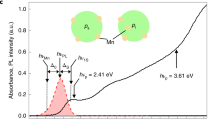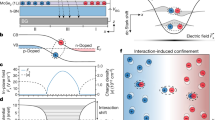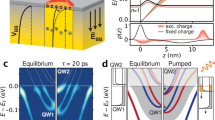Abstract
Laser-induced optical potentials for atoms have led to remarkable advances in precision measurement, quantum information and towards addressing fundamental questions in condensed-matter physics. Here, we describe analogous optical potentials for electrons in quantum wells and wires that can be generated by optically driving the transition between a single electron and a three-body electron–exciton bound state, known as a trion. The existence of a bound trion state adds a term to the a.c. Stark shift of the material proportional to the light intensity at the position of the electron. According to our theoretical calculations, this shift can be large relative to the thermal equilibrium temperature of the electron, resulting in a relatively strong optical potential that could be used to trap, guide and manipulate individual electrons within a semiconductor quantum well or wire. These potentials can be thought of as artificial nanostructures on the scale of 100 nm that can be spin dependent and reconfigurable in real time. Our results suggest the possibility of integrating ultrafast optics and gate voltages in new resolved-carrier semiconductor optoelectronic devices, with potential applications in fields such as nanoelectronics, spintronics and quantum information processing.
This is a preview of subscription content, access via your institution
Access options
Subscribe to this journal
Receive 12 print issues and online access
$209.00 per year
only $17.42 per issue
Buy this article
- Purchase on Springer Link
- Instant access to full article PDF
Prices may be subject to local taxes which are calculated during checkout



Similar content being viewed by others
References
Burstein, E., Weisbuch, C. & North Atlantic Treaty Organization Scientific Affairs Division, Confined Electrons and Photons: New Physics and Applications (Plenum Press, 1995).
Lampert, M. A. Mobile and immobile effective-mass-particle complexes in nonmetallic solids. Phys. Rev. Lett. 1, 450–453 (1958).
Finkelstein, G. et al. Charged exciton dynamics in GaAs quantum wells. Phys. Rev. B 58, 12637–12640 (1998).
Sanvitto, D. et al. Observation of charge transport by negatively charged excitons. Science 294, 837–839 (2001).
Ciulin, V. et al. Radiative lifetime of negative trions in GaAs and CdTe quantum wells. Phys. Status Solidi A 178, 495–499 (2000).
Bar-Joseph, I. Trions in GaAs quantum wells. Semicond. Sci. Technol. 20, R29–R39 (2005).
Freeman, R. R., Bucksbaum, P. H. & McIlrath, T. J. The ponderomotive potential of high-intensity light and its role on the multiphoton ionization of atoms. IEEE J. Quantum Electron. 24, 1461–1469 (1988).
Binder, R. & Lindberg, M. Optical electron–hole tweezers in semiconductors. J. Phys. Condens. Matter 18, 729–740 (2006).
Feynman, R. P. Simulating physics with computers. Int. J. Theor. Phys. 21, 467–488 (1982).
Combescot, M. & Tribollet, J. Trion oscillator strength. Solid State Commun. 128, 273–277 (2003).
Mysyrowicz, A., Hulin, D., Antonetti, A. & Migus, A. Dressed excitons in a multiple-quantum-well structure—evidence for an optical stark-effect with femtosecond response-time. Phys. Rev. Lett. 56, 2748–2751 (1986).
Combescot, M. & Combescot, R. Excitonic stark shift—a coupling to semivirtual biexcitons. Phys. Rev. Lett. 61, 117–120 (1988).
Anderson, B. P. & Kasevich, M. A. Macroscopic quantum interference from atomic tunnel arrays. Science 282, 1686–1689 (1998).
BenDahan, M., Peik, E., Reichel, J., Castin, Y. & Salomon, C. Bloch oscillations of atoms in an optical potential. Phys. Rev. Lett. 76, 4508–4511 (1996).
Greiner, M., Mandel, O., Esslinger, T., Hansch, T. W. & Bloch, I. Quantum phase transition from a superfluid to a Mott insulator in a gas of ultracold atoms. Nature 415, 39–44 (2002).
High, A. A., Novitskaya, E. E., Butov, L. V., Hanson, M. & Gossard, A. C. Control of exciton fluxes in an excitonic integrated circuit. Science 321, 229–231 (2008).
Ware, M. E. et al. Polarized fine structure in the photoluminescence excitation spectrum of a negatively charged quantum dot. Phys. Rev. Lett. 95, 177403 (2005).
Chakraborty, S., Maasilta, I. J., Tessmer, S. H. & Melloch, M. R. Imaging a two-dimensional electron system with a scanning charged probe. Phys. Rev. B 69, 073308 (2004).
Lundstrom, T., Schoenfeld, W., Lee, H. & Petroff, P. M. Exciton storage in semiconductor self-assembled quantum dots. Science 286, 2312–2314 (1999).
Portella-Oberli, M. T. et al. Dynamics of trion formation in InxGa1−xAs quantum wells. Phys. Rev. Lett. 102, 096402 (2009).
Guillet, T., Grousson, R., Voliotis, V., Wang, X. L. & Ogura, M. Local disorder and optical properties in V-shaped quantum wires: Toward one-dimensional exciton systems. Phys. Rev. B 68, 045319 (2003).
Crottini, A., Staehli, J. L., Deveaud, B., Wang, X-L. & Ogura, M. Near-field imaging of one-dimensional excitons delocalized over mesoscopic distances. Phys. Rev. B 63, 121313 (2001).
Langbein, W. & Hvam, J. M. Dephasing in the quasi-two-dimensional exciton-biexciton system. Phys. Rev. B 61, 1692–1695 (2000).
Ropers, C. et al. Atomic scale structure and optical emission of AlxGa1−xAs/GaAs quantum wells. Phys. Rev. B 75, 115317 (2007).
Kuljanishvili, I. et al. Scanning-probe spectroscopy of semiconductor donor molecules. Nature Phys. 4, 227–233 (2008).
Broocks, K. A. et al. Linear and ultrafast optical spectroscopy in the regime of the quantum Hall effect. Phys. Status Solidi B 245, 321–330 (2008).
Bethe, H. A. & Salpeter, E. E. Quantum Mechanics of One- and Two-Electron Atoms (Springer-Verlag; Academic, 1957).
Flores-Riveros, A. Generalized Hylleraas-Gaussian basis sets applied to the variational treatment of two-electron atoms. Int. J. Quantum Chem. 66, 287–300 (1998).
Schuetz, M. J. A. Trionic Optical Potentials for Charge Carriers in Semiconductors (Michigan State University, 2009).
Acknowledgements
We thank C. W. Lai and S. H. Tessmer for discussions on the experimental realizations. We acknowledge support by the National Science Foundation (C.P., M.G.M. and M.J.A.S.), the German Studienstiftung Program (M.S.) and the Fulbright Foundation (M.J.A.S.).
Author information
Authors and Affiliations
Contributions
M.J.A.S. carried out calculations; C.P. and M.G.M. proposed the concept; C.P., M.G.M. and M.J.A.S. wrote the manuscript.
Corresponding author
Ethics declarations
Competing interests
The authors declare no competing financial interests.
Supplementary information
Supplementary Information
Supplementary Information (PDF 5178 kb)
Rights and permissions
About this article
Cite this article
Schuetz, M., Moore, M. & Piermarocchi, C. Trionic optical potential for electrons in semiconductors. Nature Phys 6, 919–923 (2010). https://doi.org/10.1038/nphys1775
Received:
Accepted:
Published:
Issue Date:
DOI: https://doi.org/10.1038/nphys1775
This article is cited by
-
Few-Body Systems in Condensed Matter Physics
Few-Body Systems (2019)



